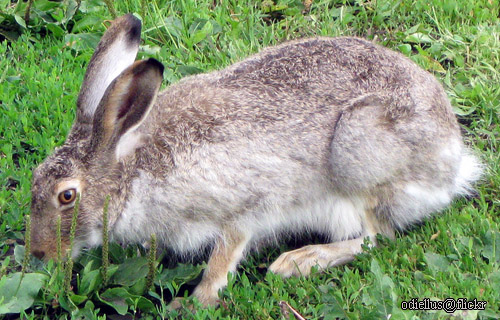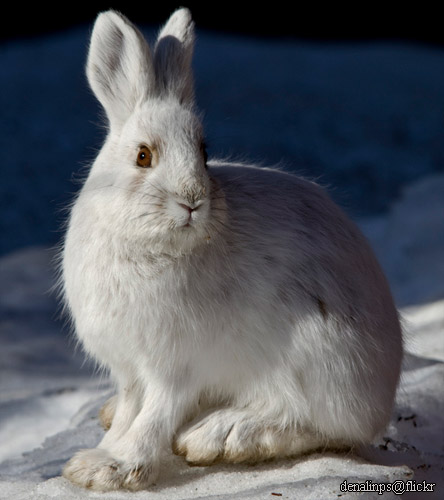Rabbits and Hares
| Latin Name | Lepus americanus, Oryctolagus cuniculus |
| Common Name | Rabbit, hare |
| Icon(s) | none |
| Snowshoe hare | |
| Snowshoe hare, winter pelt | |
| Rabbit | |
1. Description
1.1 Rabbits vs Hares
The most obvious difference between rabbits and hares is how their kits are born. Rabbits are altricial, having young that are born blind and hairless. In contrast, hares are born with hair and are able to see (precocial). All rabbits except cottontail rabbits live underground in burrows or warrens, while hares live in simple nests above the ground (as do cottontail rabbits), and usually do not live in groups. Hares are generally larger than rabbits, with longer ears, larger and longer hind legs and have black markings on their fur. Hares have not been domesticated, while European rabbits are both raised for meat and kept as pets.
For purposes of conciseness, both rabbits and hares are discussed on this page.
1.2 Snowshoe Hare (Lepus americanus)
Snowshoe hares are primarily found in boreal forests and upper montane forests; within these forests, they favor habitats with a dense shrub layer. For camouflage, its fur turns white during the winter and rusty brown during the summer. Its flanks are white year-round. The snowshoe hare is also distinguishable by the black tufts of fur on the edge of its ears. Its ears are shorter than those of most other hares.
1.3 Rabbit (Oryctolagus cuniculus)
The European rabbit is well known for digging networks of burrows, called warrens, where it spends most of its time when not feeding. The European rabbit is a smallish mammal. It has a great variety of colors: grey-brown, black, cream, tawny, gold, spotted. Domesticated rabbits were kept for various purposes: as pets, meat, for their fur and wool, etc.
Note
An important note regarding "breeds" and "types" of domesticated animals:
As with most domesticated animals formerly maintained by humans, specific "types" of this species are likely to have interbred significantly. Breeds are no longer in existence: however, traits of these particular breeds (the most frequently reared) are likely to persist in the wild landrace of this type of animal found in 'Souls.
Without selective breeding, formerly domesticated animals would breed indiscriminately. Over a few generations, it's likely they would begin to revert to their former wild type and lose some of the characteristics enforced by humans and breeding. While not enough time has passed for all selectively bred traits to disappear, it's likely many of these traits have become blended into one another.
2. Farming
Rabbits can live outside in properly constructed housing or hutches. Hutches provide protection from the elements in winter and keep rabbits cool in summer heat. To protect from predators rabbit hutches are usually situated in a fenced yard, shed, barn, or other enclosed structure. Whether housed indoors or out, all rabbits can be provided shelves, ramps or tunnels, toys or other enrichment items. Rabbit waste can be measured in cubic yards per year. This waste is excellent for gardening and composting, and can be collected for these uses whether the rabbit is housed indoors or outdoors.
3. Range
Both types are found throughout 'Souls.
4. Speech
According to our Speech Guide, this creature speaks Low Speech naturally. It is therefore not able to communicate with Luperci. This creature is listed as having the ability to learn some limited comprehension of high speech, but generally will never be able to speak it.
5. Uses
- Meat
- Pelts
6. More
7. 'Souls
- Something!



